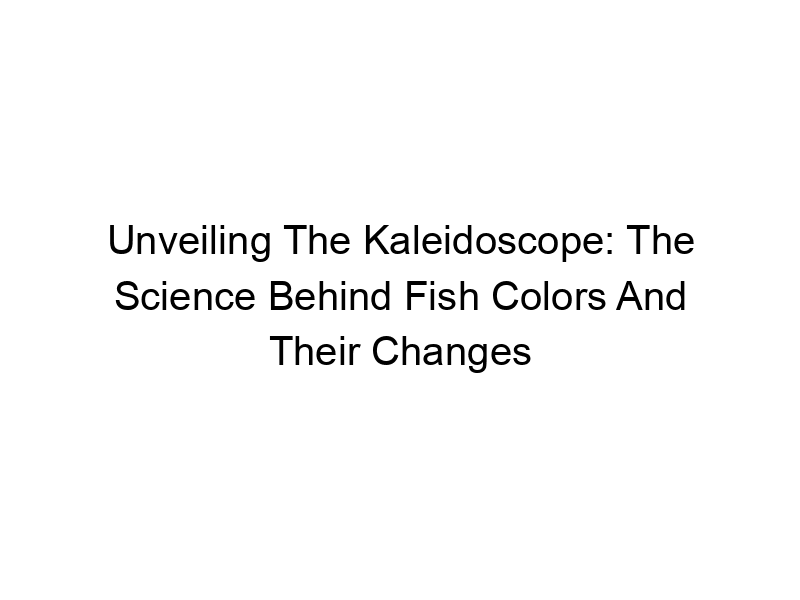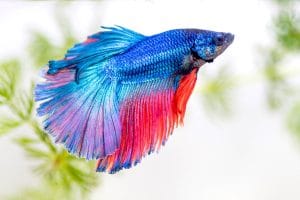Have you ever been mesmerized by the vibrant hues of a coral reef, or the subtle shifts in color of a chameleon fish? The incredible diversity and dynamism of fish coloration is far more than just aesthetically pleasing; it’s a complex interplay of biological mechanisms with profound implications for survival and communication. The science behind fish colors: why do they change? This comprehensive guide will delve into the fascinating world of fish pigmentation, exploring the chemical and physical processes that create these stunning displays, and examining why and how fish colors shift and adapt. We’ll cover the roles of chromatophores, the influence of light, the impact of environment, and the intricate communication strategies reliant on color change. Prepare to be amazed by the intricate science behind this underwater spectacle.
Fish
coloration is primarily governed by specialized pigment-containing cells called chromatophores. These microscopic powerhouses come in several varieties, each responsible for a specific color. Melanophores contain melanin, producing black and brown hues. Xanthophores house carotenoids, creating yellow and red colors. Erythrophores, similar to xanthophores, also produce reds and oranges. Finally, iridophores, unlike the pigment-based chromatophores, create iridescent effects through the scattering of light using guanine crystals. The interplay and relative distribution of these cell types determine the overall coloration of the fish.
The Chemistry of Color: Pigments and Reflectors
Pigment Production and Distribution
The synthesis and distribution of pigments within chromatophores are complex biochemical processes influenced by various factors including genetics, hormones, and environmental stimuli. For instance, certain hormones can trigger the expansion or contraction of chromatophores, resulting in rapid color changes. The precise chemical pathways involved are still areas of active research, but we understand that melanin synthesis, for instance, is regulated by a cascade of enzymes and signaling molecules.
The Physics of Color: Light and Reflection
Structural Coloration: Iridescent Effects
While pigment-based coloration is relatively straightforward, structural coloration adds an extra layer of complexity. This type of coloration arises not from pigments but from the way light interacts with microscopic structures within the fish’s skin. Iridophores, with their guanine crystals, perfectly illustrate this. The arrangement of these crystals determines how light is reflected and refracted, leading to shimmering, iridescent effects that can change dramatically with the angle of observation. This is similar to how a soap bubble displays a rainbow of colors.
Environmental Triggers: Camouflage and Adaptation
Mimicry and Background Matching
Fish often change color to blend seamlessly with their surroundings, a phenomenon known as camouflage. This is particularly crucial for prey species that need to avoid predators. Many species exhibit remarkable background matching abilities, altering their coloration to mimic the texture and color of the substrate or surrounding vegetation. This allows them to effectively “disappear” from both predators and prey.
Hormonal Influence: Neuroendocrine Control
The Role of Hormones in Color Change
The nervous system plays a crucial role in regulating color changes. Neurons can release neurotransmitters that influence the expansion and contraction of chromatophores, causing rapid color shifts in response to environmental cues or social interactions. Hormones also exert a significant influence, with melanocyte-stimulating hormone (MSH) being a key player in controlling melanin distribution.
Social Signals: Communication and Courtship
Color Change in Territorial Disputes and Mate Attraction
Color changes are not merely defensive strategies; they are also essential tools for communication. Many species use color to signal aggression during territorial disputes or to attract mates. Bright, flashy colors often signal dominance or fitness, influencing courtship behaviors and reproductive success. The rapid color shifts can be a form of visual display during these interactions, conveying information at a glance.
The Role of Light: Photoreception and Color Adjustment
Photoreceptors and Environmental Light Levels
Light plays a crucial role in fish coloration. Fish possess specialized photoreceptors that detect changes in light intensity and wavelength. This information is processed by the nervous system, influencing chromatophore activity and allowing fish to adjust their coloration to match the prevailing light conditions. This dynamic response ensures optimal camouflage and communication.
Genetic Basis of Coloration: Inheritance and Variation
Genes and Pigmentation
The genes responsible for color production and chromatophore development are a subject of intense research. Studies are revealing the complex genetic networks that regulate pigment synthesis, transport, and distribution within chromatophores. Mutations in these genes can lead to variations in coloration, contributing to the vast diversity observed in fish species.
Species-Specific Adaptations: Unique Coloration Strategies
Examples of Specialized Color Adaptations
Different fish species have evolved unique adaptations related to coloration. For example, some deep-sea fish possess bioluminescent organs to produce light, attracting prey or mates in the perpetually dark abyss. Others exhibit dramatic color changes linked to reproductive cycles, with males exhibiting strikingly different colors during breeding season.
Technology and Fish Coloration Research: Modern Techniques
Spectrophotometry and Microscopy
Modern scientific tools have revolutionized our understanding of fish coloration. Techniques such as spectrophotometry, which measures the reflection and absorption of light, allow precise quantification of coloration. Microscopy enables detailed examination of chromatophore structure and arrangement at a cellular level, giving valuable insights into the mechanisms of color change.
The Evolutionary Significance of Color: Natural Selection
Coloration and Survival
Coloration plays a pivotal role in the evolution and survival of fish. Natural selection favors individuals with coloration that enhances their survival and reproductive success. This leads to the evolution of diverse coloration strategies, reflecting the selective pressures imposed by predators, prey, and the environment.
Color Blindness in Fish: A Unique Perspective
Visual Systems and Color Perception
While humans are typically trichromatic (seeing three primary colors), the visual systems of fish are highly diverse. Some species are dichromatic (two primary colors), while others possess tetrachromatic or even more complex visual systems, capable of perceiving a broader range of colors than humans. This variety in color vision has profound implications for the evolution of fish coloration.
Human Impact: Pollution and Habitat Degradation
Environmental Threats and Color Changes
Pollution and habitat degradation pose significant threats to fish populations, including impacting their coloration. Changes in water quality or light availability can affect pigment production and distribution, potentially altering camouflage effectiveness or disrupting communication signals. This highlights the delicate balance between fish coloration and their environment.
Conservation Implications: Protecting Color Diversity
Maintaining Biodiversity and Color Variation
Protecting fish biodiversity is crucial for maintaining the stunning variety of coloration observed in aquatic ecosystems. Conservation efforts must consider the complex interactions between fish coloration, their environment, and their survival strategies. Protecting habitats and reducing pollution are critical steps in ensuring the continued diversity of fish colors for future generations.
The Future of Fish Coloration Research: Unanswered Questions
Ongoing Research and Future Directions
Despite significant advancements, numerous questions about fish coloration remain unanswered. Further research is needed to fully understand the intricate genetic and biochemical mechanisms underlying pigment production and color change. Exploring the evolutionary history and adaptive significance of specific coloration strategies will provide invaluable insights into the fascinating world of fish.
Frequently Asked Questions
What are the primary types of chromatophores?
The primary types of chromatophores are melanophores (black and brown), xanthophores (yellow and red), erythrophores (red and orange), and iridophores (iridescent).
How do fish change color so quickly?
Rapid color changes are facilitated by the expansion and contraction of chromatophores, controlled by hormonal and neural signals.
What is the role of light in fish coloration?
Light plays a crucial role in determining how fish colors appear, and fish have photoreceptors to adjust their color to prevailing light levels.
Why do some fish have iridescent colors?
Iridescent colors are created by structural coloration, through the reflection and refraction of light by microscopic structures, often guanine crystals in iridophores.
How does camouflage help fish survive?
Camouflage allows fish to blend with their surroundings, protecting them from predators and enhancing their ability to ambush prey.
What role do hormones play in color change?
Hormones like melanocyte-stimulating hormone (MSH) regulate pigment distribution within chromatophores, influencing color changes.
How does fish coloration relate to communication?
Color changes are essential communication signals, used in territorial displays, courtship rituals, and other social interactions.
What are some examples of fish species with unique color adaptations?
Examples include deep-sea fish with bioluminescence, and many species with breeding-season color shifts.
Final Thoughts
The science behind fish colors and their ability to change is a marvel of natural engineering. From the intricate chemistry of pigments to the physics of light reflection, and the complex biological mechanisms orchestrating color shifts, the topic is far more than just aesthetics. It’s a vibrant tapestry woven from evolution, survival strategies, and intricate communication methods. By understanding this intricate science, we appreciate the delicate balance of nature and the importance of conservation efforts in protecting these amazing creatures and their stunning color palettes. The world of fish coloration is vast and endlessly fascinating, continually revealing new insights into the beauty and complexity of the underwater world. Further exploration awaits those curious enough to dive deeper!




